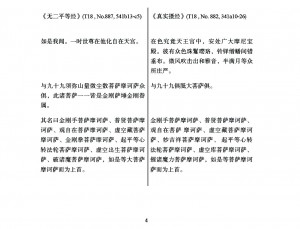Paṇḍita Kavirāja Saddharmarāja Bajrācārya Śāstrī (tr.) Ārya Mañjuśrī Nāmasaṅgīti: advayaparamārtha nāmasaṅgīti. Ācārya Vilāsavajra kṛta Nāmamantrārthaavalokinī Ārya Mañjuśrī Nāmasaṅgītiyāgu ṭīkāyā lidhaṃsāy, ṭippaṇī va bhāvārthasahita Nepālabhāṣāy saṅkṣipta anuvāda. Lalitapura: Rāmeśa Maharjana saparivāra, VS 2068 [2011 CE]. na+320 pp.
Facsimile Edition of All Palmleaf MSS in the TAR (2012?)
བོད་རང་སྐྱོང་ལྗོངས་སུ་ཉར་ཚགས་བྱས་པའི་ཏ་ལའི་ལོ་མའི་དཔེ་ཆ་ཀུན་བཏུས་པར་མ།
《西藏自治区珍藏贝叶经影印大全》(共61分册)
*Facsimile Edition of Palmleaf Manuscripts in the Tibet Autonomous Region: Complete Collection. 2012(?). 61 vols.བོད་རང་སྐྱོང་ལྗོངས་སུ་ཉར་ཚགས་བྱས་པའི་ཏ་ལའི་ལོ་མའི་དཔེ་ཆ་ཀུན་བཏུས་ཀྱི་དཀར་ཆག་བསྡུས་པ།
《西藏自治区珍藏贝叶经影印大全简目》
*Facsimile Edition of Palmleaf Manuscripts in the Tibet Autonomous Region: Complete Collection. Brief Index. 2012(?).བོད་རང་སྐྱོང་ལྗོངས་སུ་ཉར་ཚགས་བྱས་པའི་ཏ་ལའི་ལོ་མའི་དཔེ་ཆ་བྲིས་མའི་རྩ་བའི་དཀར་ཆག།
《西藏自治区珍藏贝叶经总目录》(共4册)
*Master Catalogue of Palmleaf Manuscripts in the Tibet Autonomous Region. 2012(?). 4 vols.

Continue reading “Facsimile Edition of All Palmleaf MSS in the TAR (2012?)”
Sonam Tsemo (Xu tr.), Intro to Buddhist Tantra (2012)
薩迦二祖索南孜莫(作者), 許明銀(譯者) 《印度西藏密教概論:認識最初之體系性密教概說》 大千出版社 2012年12月22日
Sa skya Bsod rnams rtse mo [b.1142], Xu Ming Yin [b. 1952] (tr.). Yindu Xizang mi jiao gai lun: ren shi zui chu zhi ti xi xing mi jiao gai shuo [*Introduction to Indo-Tibetan Tantric Buddhism: Understanding the first systematic primer on tantra(?)]. Taipei: Darchen, 2012. ISBN: 9789574472673 [books.com.tw]
A partial Chinese translation of the earliest rGyud sde spyi’i rnam par gzhag pa. See Xu’s unofficial introduction.
On not reviewing Wedemeyer’s ‘Making Sense’

Currently I have no plans to review Christian Wedemeyer’s Making Sense of Tantric Buddhism (2012), but that’s not to say that it shouldn’t be reviewed. Just a couple of months after its release, it is now on the shelves of over 80 libraries. Moreover, Dr. Wedemeyer promises to publish a minimum of three more volumes on the Śrīsamāja. Hopefully someone — who isn’t me — will soon get around to a review.
Ōtsuka, *Formation of Early Indian Tantric Buddhism (2013)
大塚 伸夫 『インド初期密教成立過程の研究』 春秋社 (2013/1/31) 23,100円
Ōtsuka, Nobuo. Indo shoki mikkyō seiritsu katei no kenkyū (*Studies on the Formation Process of Early Indian Tantric Buddhism). Tokyo: Shunjūsha, January 31, 2013. 1100 pp. ISBN-13: 978-4393113110 [official site unofficial summary at Taishō U.]
Tanaka, Samājasādhanavyavastholī 4 (2012)
Tanaka, ‘Nāgabodhi’s *Samājasādhanavyavasthālī II’ (2011)
田中 公明 「『秘密集会』の身体曼荼羅論 : Nāgabodhiの安立次第論』第2章サンスクリット写本ローマ字化テキスト」 『東洋文化研究所紀要』 第160冊 2011.12
Tanaka, Kimiaki. ‘Nāgabodhi’s *Samājasādhanavyavasthālī: The Tibetan Translation and Sanskrit Text of Chapter II’ [in Japanese]. Tōyō Bunka Kenkyūjo kiyō 160, 2011, pp. 324(313)–338(299). [URI / PDF]
From the Abstract
“In this article I have transcribed the Sanskrit text of Chapter II of the Vyavasthālī. This chapter mainly explains the body-maṇḍala theory of the Guhyasamāja-tantra. For further details, reference should be made to pp. 333-324.”
Fan, ‘Advayasamatāvijaya: the Sanskrit MS in Tibet’ (2011)
范慕尤 (作者) 《梵文写本《无二平等经》的对勘与研究》
梵文贝叶经与佛教文献系列丛书② 中西书局 2011.12Fan, Muyou. Advayasamatāvijaya: A Study Based upon the Sanskrit Manuscript Found in Tibet. Series of Sanskrit Manuscripts & Buddhist Literature 2. Shanghai: Zhongxi Book Company. 10+356+13 pp. 2011. ISBN 978-7-5475-0303-4. [English introduction]
(Via RISM)
Nice to see this new publication. Pardon me, though, if part of it seems just a little too familiar. Compare page 4ff of the front matter, on the parallels between the opening of the Advayasamatāvijaya (missing in Fan’s Sanskrit MS) and the STTS, presented as the author’s own work:
with the beginning of a document prepared for Dr. Fan in 2008:
Sincerely flattered, I am.
Wright, ‘The Guhyasamāja Piṇḍikṛta-sādhana’ (2010)
Roger Wright. ‘The Guhyasamāja Piṇḍikṛta-sādhana and its context’. MA thesis (Religions), School of Oriental and African Studies, 2010. [PDF (‘internet version’)]
From the Abstract (sic)
This paper analyses and comments on the Piṇḍikṛta-sādhana, a ritual practice manual for the Guhyasamāja Highest Yoga Tantra, attributed to Nāgārjuna. It is based on a correlated translation of the Sanskrit and Tibetan versions of the text prepared for the purpose. […]
Particular attention has been given to making the translation of the visualizations of the architecture and the deities themselves clear by providing tables and illustrations. The philosophical background of the text is investigated and the way in which that was subtly altered by subsequent commentators when it no longer fitted the later “philosophical climate” is made clear. The continuity of the practice is discussed, from its inception to the present day.






